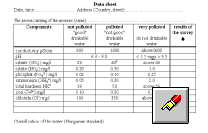
SUMMARY
"Undersurface waters" project
The project
Project method is fairly new in our country. Unfortunately, nowadays this word is becoming more and more popular without realizing its real meaning. Occording to our interpretation it means that the participants outline a topic chosen together, than the parts of the problem are carried out by the members, on the basis of their individual activities. It is typical that there are no inflexible verges, new considerations, new elements and results can emerge during the process which we can build into our plan as they are flexible. It also can happen that we have to give up some of our plans, because our financial posibilites have changed, or an expert of a special part of the problem has left the project.
The advantages of this method:
-It is collective work from the choise of topic to summarizing the results.
-The activity is collective but the individuals have their own tasks which they are good at.
-We get complex knowledge of the examined topics.
-Several age-groups can take part in the work.
-Pupils who are not so succesful in their studies at school can be succesful in the project.
-The leader of the project cooperates with the other members, that is why this is one of the most democratic pedagogical methods.
We share our experience with other groups with pleasure, we also show our methods to them.
The brief account of the project "Undersurface waters"
The surface of the soil is a natural frontier between the surface of the Earth and the lower strata. The surface is in our sight, and the lower strata are hidden, but their condition is also very important. Unfortunatelly, mankind is not aware of the fact that the environmental pollution spreads over the surface waters, which also makes undersurface waters polluted. It is not vare that we pollute ground water by letting sewage into our wells. The aim of our surveys were to examine the quality of the waters. We worked together with several school groups and we examined the quality of the waters in several settlements.
We would like:
- to show an example to the participant students and teachers how to work in project method.
- to draw the attention of the inhabitants and the local councils to the importance of clearness of our surface and undersurface waters.
The basic documents and equipment of the activity
- Sheets describing the problems and the measuring
- Data sheets which show the measuring results to the enhabitants and the local councils.
- Measuring tools (quicktests for waterchemical measuring).
The expected advantages of the program
To complete the already available measuring results we are spreading the survey on further areas and so we hope to get a fuller view of the condition of undersurface waters. The social organizations and school groups can inform the local councils and the inhabitants and change their approach. They can also initiate steps like building sewerage system, sewerage transportation, revise sewerage orders of the local councils...
A brief problem exploration
One of our main problems is the lack of clean drinking water nowadays. Our surface and undersurface waters are getting more and more polluted. It is mainly because of inconsiderate human activity. Industrial plants spoil the soil and the waters with not well cleaned sewage; the agriculture does the same with artifical fertilizer. Sometimes, even in the sewered settlements, there are not suitable sewage farms. And where there is no drainage system, people let the sewage go into the wells or the soil. All these pollute our drinking water and soil water.
What can we do?
- We should economize on water - so there will be less sewage.
- We should use washing up liquid and washing powder free of phosphate.
- We should avoid using artifical fertilizer - let's use natural fertilizer.
- Local councils and the inhabitants should have sewage systems and sewage farms.
Pollution materials:
Nitrat (NO3 -), Nitrit (NO2-) — from artifical fertilizer and communal pollution.
Phosphat (PO43-) — from communal pollution and artifical fertilizer.
Ammonium (NH4+) — from organic pollutions. (Ammonium indicated fresh pollution it is also very frequent.)
Conductivity — from non identifical pollutions
pH — from non identifical pollutions (primary: organic pollutions).
The method of the examination
Sampling: about 100-200 cm3 of water is enough. We take the water with a bucket or bottle bound on a string from a well. The sample always has to be freshly taken and examined at once.
Method survay: see user guide of chemical tests!
The data sheet: